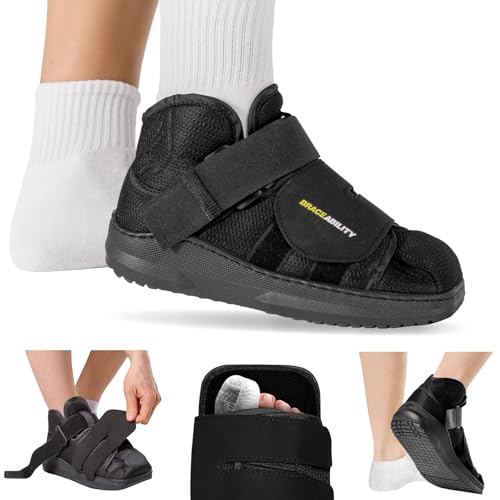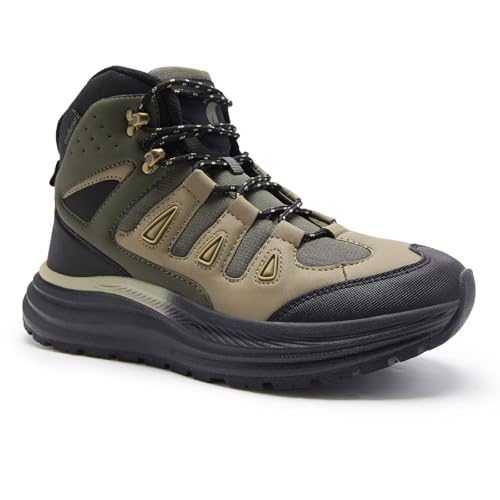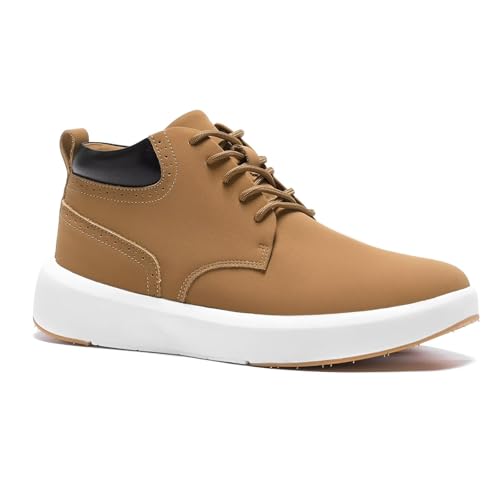Does your foot roll inward too much when you walk or run? This common issue, called overpronation, can lead to aches and pains in your feet, ankles, knees, and even your hips. If you’ve ever felt that nagging discomfort after a long day on your feet, or struggled to find shoes that just feel *right*, then you know the frustration. The sheer number of boots out there, each claiming to be the solution, can make choosing the perfect pair feel like a treasure hunt with no map.
But what if you could finally find boots that offer the support and comfort you need to move freely and pain-free? This post is here to guide you through the maze of options. We’ll break down what to look for in boots for overpronation, making it easier for you to understand the key features and find a pair that will keep your feet happy and healthy. Get ready to step into a world of better support and less discomfort!
Our Top 5 Boots For Overpronation Recommendations at a Glance
Top 5 Boots For Overpronation Detailed Reviews
1. BraceAbility Closed Toe Medical Walking Shoe – Lightweight Broken Toe Cast Boot
Rating: 9.4/10
The BraceAbility Closed Toe Medical Walking Shoe is a fantastic option for anyone recovering from foot injuries or surgery. It’s designed to be comfortable and supportive, helping you heal safely. This boot works for many different foot problems, like broken toes, stress fractures, or after bunion surgery. It’s made for both men and women and comes in different sizes to ensure a good fit.
What We Like:
- It offers great protection for your foot, ankle, and leg after surgery or an injury.
- The closed-toe design keeps bandages clean and dry, which is super helpful.
- The roomy toe box handles swelling well and protects your foot from more harm.
- Its non-skid sole gives you good grip on different surfaces, so you can walk safely inside or outside.
- The boot is lightweight and has adjustable straps for a custom, secure fit.
- It helps reduce pain in your foot and heel while you walk.
What Could Be Improved:
- Finding the exact right size might take some careful looking at the size chart.
- While it’s adjustable, some users might prefer even more padding for long-term wear.
This walking shoe is a solid choice for supporting your recovery. It helps you move around more comfortably and safely as your foot heals.
2. Men’s Orthopedic Hiking Boots: Fit Arch Support Orthotic Ergonomic Plantar Fasciitis Foot Pain Relief Ankle Boots
Rating: 9.1/10
Tired of foot pain holding you back? These Men’s Orthopedic Hiking Boots are designed to help you conquer any trail or just make your day more comfortable. They offer great support for your feet and ankles. Whether you’re hitting the trails, standing for long periods, or just hanging out, these boots aim to provide relief and comfort.
What We Like:
- These boots have built-in arch support. They help with pain from flat feet and plantar fasciitis. Your feet will feel more aligned and comfortable all day.
- The mid-cut ankle design gives extra support. It helps protect your ankles on bumpy ground. This makes hiking and walking feel safer.
- They have a soft, bouncy midsole. This absorbs shock with every step. It reduces tiredness in your joints, perfect for work, travel, or outdoor fun.
- The strong rubber sole gives great grip. It keeps you from slipping on wet or rocky paths. You can trust your footing on trails or city streets.
- The boots are made with breathable material. This keeps your feet cool and dry. They look good and work well for hiking, training, or just daily wear.
What Could Be Improved:
- While they offer good support, some users might find the initial break-in period a little stiff.
- The style is functional, but a wider range of color options could appeal to more fashion-conscious individuals.
These boots offer a solid blend of comfort and support. They are a good option for anyone seeking relief from foot pain during active days.
3. Men’s Orthopedic Leather Ankle Boots: Stylish Ankle Arch Support Overpronation Diabetic Leisure Driving Oxfords
Rating: 8.5/10
Step into comfort and style with these Men’s Orthopedic Leather Ankle Boots. They offer a blend of support and fashion, making them a smart choice for daily wear, work, and even light outdoor adventures. These brown, size 11 boots are designed to help your feet feel great all day long.
What We Like:
- The boots give your ankles strong support. This helps keep your ankles steady and stops them from rolling. It’s great for walking and working.
- They are built with foot conditions in mind. People with flat feet, plantar fasciitis, or heel pain will find them very comfortable. The design spreads your weight evenly.
- These boots are made from good quality leather. This makes them last a long time and look good. They are comfortable and stylish for many uses.
- The inside of the boots has special arch support. This helps your feet stay in the right position. The soft padding also absorbs shock, making it easier to walk or stand for long periods.
- They look good and can be worn for many occasions. You can wear them when you’re out and about, at work, or even for casual sports. The laces let you adjust the fit for your comfort.
What Could Be Improved:
- While versatile, they might not be ideal for rugged hiking or very demanding sports.
- The term “Oxfords” might suggest a more formal shoe than these boots are intended for.
These ankle boots offer excellent support and a stylish look for anyone needing extra care for their feet. They are a solid choice for combining comfort and everyday fashion.
4. Dr. Scholl’s Stability Support Insoles
Rating: 8.5/10
Tired of foot, knee, or back pain holding you back? Dr. Scholl’s Stability Support Insoles are here to help. These insoles are specifically designed for people with flat feet, low arches, or overpronation. They work to improve your balance and stability, so you can move more comfortably all day long. You can even trim them to fit perfectly in your shoes.
What We Like:
- These insoles really boost your stability. This helps you keep your balance and stand up straighter.
- They offer great arch support. This is perfect for people with flat feet or weak arches.
- The insoles help reduce pain. You’ll feel relief in your feet and heels, and even in your knees, hips, and lower back.
- The shock-absorbing heel cup cushions your foot. It also helps keep your ankle in place and lowers stress on your lower body.
- They are doctor recommended. Many people love how these insoles feel.
- You can trim them to fit almost any shoe. This makes them super versatile.
What Could Be Improved:
- While they offer great support, some users might find the initial feel a bit firm.
- The sizing might require careful measuring to ensure the best fit for your specific shoe.
If you’re looking for better support and less pain, these Dr. Scholl’s insoles are a solid choice. They help you get back to doing the activities you enjoy with more comfort.
5. Women’s Orthopedic Wide Leather Winter Ankle Boots for Diabetic: Fashionable Arch Support Walking Shoes for Flat Feet
Rating: 9.4/10
Step into comfort and style this winter with these Women’s Orthopedic Wide Leather Winter Ankle Boots. Designed specifically for those who need extra support and protection, these boots offer a fashionable solution for diabetic feet, flat feet, and common foot pain issues like plantar fasciitis and overpronation.
What We Like:
- The detachable TPU support is a game-changer. It lets you customize the arch support to exactly what your feet need, which is super helpful if you have diabetes and can’t always feel foot problems early.
- These are fantastic winter boots! The ankle height keeps your feet and ankles warm and protected from snow and wet conditions. The waterproof leather is a big plus.
- The wide toe box is a lifesaver. It gives your toes plenty of room to spread out, which is great for swollen feet and helps prevent pain from bunions and hammertoes.
- You get serious foot pain relief with these. The cushioning and soft interior protect sensitive feet from irritation. They’re perfect for people with heel pain, plantar fasciitis, arthritis, and more. They also help reduce leg fatigue.
- These boots are surprisingly versatile. You can wear them for daily walks, parties, skiing, walking the dog, driving, going to work, or just a quick trip to get the mail. They blend comfort and style for almost any occasion.
What Could Be Improved:
- While the boots offer great support, the style might be a bit too functional for some fashion-forward individuals looking for a dressier boot.
- The “dress shoe” aspect might be a stretch for formal events; they lean more towards comfortable casual and walking attire.
These boots are a smart choice for anyone seeking both warmth and significant foot support this winter. They offer a great combination of features for everyday comfort and protection.
Finding the Right Boots for Overpronation: Your Ultimate Guide
Overpronation happens when your foot rolls inward more than it should during walking or running. This can cause foot pain, shin splints, and knee problems. The right boots can help support your feet and correct this issue. This guide will help you find the best boots for overpronation.
Key Features to Look For
1. Arch Support
Good arch support is crucial. Boots with a well-defined arch help keep your foot in a neutral position. This prevents your arch from collapsing too much inward.
2. Firm Midsole
The midsole is the cushioning layer between the outsole and the upper. A firm midsole offers stability. It controls the inward rolling motion of your foot.
3. Heel Counter
The heel counter is the stiff material at the back of the boot that cups your heel. A strong heel counter locks your heel in place. This reduces excessive movement and supports your ankle.
4. Motion Control
Some boots are designed for motion control. They use special technologies to limit how much your foot rolls inward. This is very helpful for severe overpronation.
5. Wide Toe Box
A wide toe box gives your toes room to spread out. This improves comfort and balance. It also helps prevent bunions or hammertoes.
Important Materials
1. Uppers
Look for durable materials like leather or synthetic leather. These offer good support and protection. Mesh can also be used for breathability, but ensure it’s reinforced for stability.
2. Midsoles
EVA (ethylene-vinyl acetate) and PU (polyurethane) are common midsole materials. EVA is lighter and offers good cushioning. PU is denser and provides more durable support and stability, which is often better for overpronation.
3. Outsoles
Rubber outsoles provide good traction and durability. Some outsoles have specific tread patterns designed to guide your foot through a more neutral stride.
Factors That Improve or Reduce Quality
1. Construction Quality
Boots with strong stitching and a well-bonded sole tend to last longer. Poor construction can lead to premature wear and loss of support.
2. Cushioning vs. Stability
While cushioning is nice, for overpronation, stability is more important. Too much soft cushioning can actually make overpronation worse by allowing the foot to sink in too much.
3. Fit
A proper fit is essential. Boots that are too tight or too loose won’t provide adequate support. Always try boots on before buying, ideally later in the day when your feet are slightly swollen.
User Experience and Use Cases
1. Everyday Wear
Many boots designed for overpronation offer stylish options for daily use. They provide comfort and support whether you’re running errands or walking around town.
2. Hiking and Outdoor Activities
For outdoor adventures, look for hiking boots with excellent ankle support and a sturdy sole. These boots help navigate uneven terrain while controlling pronation.
3. Work Boots
If your job requires long hours on your feet, work boots with overpronation support can make a huge difference in comfort and preventing fatigue.
Frequently Asked Questions (FAQ) About Boots for Overpronation
Q: What is overpronation?
A: Overpronation is when your foot rolls inward too much as you walk or run.
Q: How do boots help with overpronation?
A: Boots with good arch support, a firm midsole, and a strong heel counter help control the inward rolling of your foot.
Q: Should I look for boots with extra cushioning?
A: Not necessarily. While cushioning is good, too much soft cushioning can be bad for overpronation. Stability is more important.
Q: What is a heel counter?
A: The heel counter is the stiff part at the back of the boot that holds your heel securely.
Q: Are motion control boots necessary?
A: Motion control boots are very helpful if you have significant overpronation. They are designed to limit inward foot rolling.
Q: What materials are best for the midsole?
A: PU (polyurethane) is often better than EVA for overpronation because it’s denser and offers more stability.
Q: How do I know if a boot has good arch support?
A: You should feel a noticeable curve or support under your arch when you try the boot on.
Q: Can I wear any boots for overpronation?
A: No. You need boots specifically designed with features to support and correct overpronation.
Q: When is the best time to try on boots?
A: Try on boots in the afternoon or evening when your feet are a bit swollen for the most accurate fit.
Q: Where can I find good boots for overpronation?
A: Look in specialty shoe stores or online retailers that offer detailed product descriptions and customer reviews.
In conclusion, every product has unique features and benefits. We hope this review helps you decide if it meets your needs. An informed choice ensures the best experience.
If you have any questions or feedback, please share them in the comments. Your input helps everyone. Thank you for reading.

Hi, I’m Hector Quintanilla, the creator of helmetslab.com.. As a passionate enthusiast and experienced expert in helmets, I’ve dedicated this platform to sharing my insights, knowledge, and hands-on experiences. Whether you’re seeking the best helmet for safety, comfort, or performance, my goal is to guide you with detailed reviews, tips, and advice. Ride safe, and let’s explore the world of helmets together!





